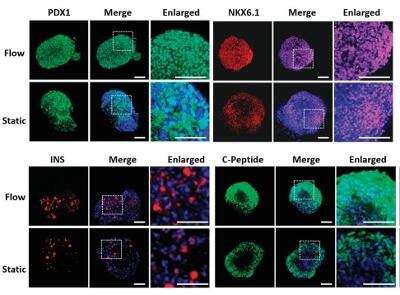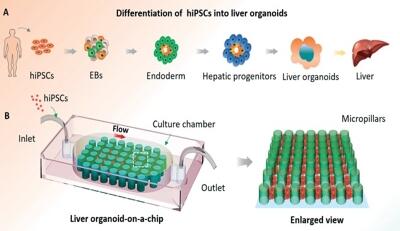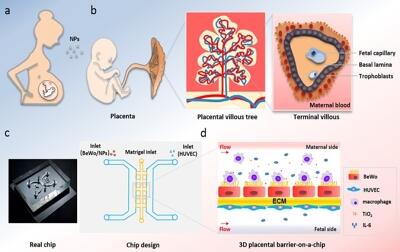Engineering human islet organoids from iPSCs using an organ-on-chip platform |
We present a new strategy to engineer human islet organoids derived from human induced pluripotent stem cells (hiPSCs) using an organ-on-achip platform combined with stem cell developmental principles. The microsystem contains a multi-layer microfluidic device that allows controllable aggregation of embryoid bodies (EBs), in situ pancreatic differentiation and generation of heterogeneous islet organoids in parallel under perfused 3D culture in a single device. The generated islet organoids contain heterogeneous islet-specific α and β-like cells that exhibit favorable growth and cell viability. This islet-on-a- chip system is robust and amenable to real-time imaging and in situ tracking of islet organoid growth, which may provide a promising platform for organoid engineering, disease modeling, drug testing and regenerative medicine. |

|
|
Lab Chip, 2019, 19, 948–958 (Cover image) |
In situ differentiation and generation of functional liver organoids from human iPSCs in a 3D perfusable chip system |
We described a new strategy for engineering liver organoids derived from human induced PSCs(hiPSCs) in a 3D perfusable chip system by combining stem cell biology with microengineering technology. This approach enabled formation of hiPSC-based embryoid bodies (EBs), in situ hepatic differentiation, long-term 3D culture and generation of liver organoids in a perfusable micropillar chip. The generated liver organoids exhibited favorable growth and differentiation of hepatocytes and cholangiocytes, recapitulating the key features of human liver formation with cellular heterogeneity. The established liver organoid-on-a-chip system may provide a promising platform for engineering stem cell-based organoids with applications in regenerative medicine, disease modeling and drug testing. |

|
|
Lab on a Chip, 2018, DOI: 10.1039/c8lc00869h |
A 3D human placenta-on-a-chip model to probe nanoparticle exposure at the placental barrier |
We proposed a microengineered 3D placental barrier-on-a-chip microdevice and further explored complicated placental responses to NPs exposure in vitro. The microdevice recreated near-physiological 3D microenvironment and dynamic conditions in fetal maternal circulation combined with the extracellular matrix and flow. This in vitro experimental model of human placenta provides a simple platform to study environmental exposure to NPs, and might be potential for a wide range of applications in biological study, disease treatment and drug assessment. |

|
|
Toxicology in Vitro, 2018,54: 105-113 |

 Research Interests
>
正文
Research Interests
>
正文